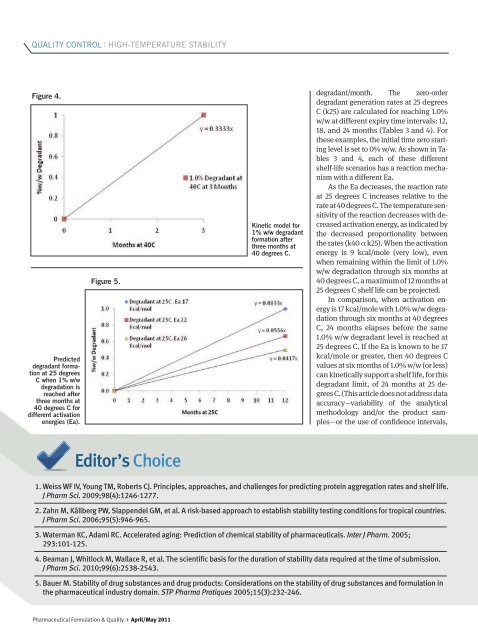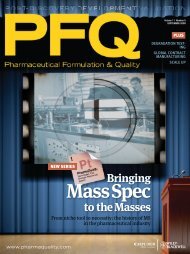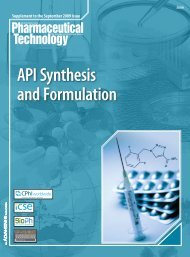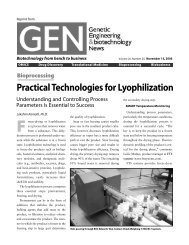QUALITY CONTROL | HIGH-TEMPERATURE STABILITYFigure 4.Predicteddegradant <strong>for</strong>mationat 25 degreesC when 1% w/wdegradation isreached afterthree months at40 degrees C <strong>for</strong>different activationenergies (Ea).Figure 5.Kinetic model <strong>for</strong>1% w/w degradant<strong>for</strong>mation afterthree months at40 degrees C.degradant/month. The zero-orderdegradant generation rates at 25 degreesC (k25) are calculated <strong>for</strong> reaching 1.0%w/w at different expiry time intervals: 12,18, and 24 months (Tables 3 and 4). For<strong>the</strong>se examples, <strong>the</strong> initial time zero startinglevel is set to 0% w/w. As shown in Tables3 and 4, each of <strong>the</strong>se differentshelf-life scenarios has a reaction mechanismwith a different Ea.As <strong>the</strong> Ea decreases, <strong>the</strong> reaction rateat 25 degrees C increases relative to <strong>the</strong>rate at 40 degrees C. The temperature sensitivityof <strong>the</strong> reaction decreases with decreasedactivation energy, as indicated by<strong>the</strong> decreased proportionality between<strong>the</strong> rates (k40 α k25). When <strong>the</strong> activationenergy is 9 kcal/mole (very low), evenwhen remaining within <strong>the</strong> limit of 1.0%w/w degradation through six months at40 degrees C, a maximum of 12 months at25 degrees C shelf life can be projected.In comparison, when activation energyis 17 kcal/mole with 1.0% w/w degradationthrough six months at 40 degreesC, 24 months elapses be<strong>for</strong>e <strong>the</strong> same1.0% w/w degradant level is reached at25 degrees C. If <strong>the</strong> Ea is known to be 17kcal/mole or greater, <strong>the</strong>n 40 degrees Cvalues at six months of 1.0% w/w (or less)can kinetically support a shelf life, <strong>for</strong> thisdegradant limit, of 24 months at 25 degreesC. (This article does not address dataaccuracy—variability of <strong>the</strong> analyticalmethodology and/or <strong>the</strong> product samples—or<strong>the</strong> use of confidence intervals,Editor’s Choice1. Weiss WF IV, Young TM, Roberts CJ. Principles, approaches, and challenges <strong>for</strong> predicting protein aggregation rates and shelf life.J Pharm Sci. 2009;98(4):1246-1277.2. Zahn M, Kållberg PW, Slappendel GM, et al. A risk-based approach to establish stability testing conditions <strong>for</strong> tropical countries.J Pharm Sci. 2006;95(5):946-965.3. Waterman KC, Adami RC. Accelerated aging: Prediction of chemical stability of pharmaceuticals. Inter J Pharm. 2005;293:101-125.4. Beaman J, Whitlock M, Wallace R, et al. The scientific basis <strong>for</strong> <strong>the</strong> duration of stability data required at <strong>the</strong> time of submission.J Pharm Sci. 2010;99(6):2538-2543.5. Bauer M. <strong>Stability</strong> of drug substances and drug products: Considerations on <strong>the</strong> stability of drug substances and <strong>for</strong>mulation in<strong>the</strong> pharmaceutical industry domain. STP Pharma Pratiques 2005;15(3):232-246.Pharmaceutical Formulation & Quality > April/May 2011
PHARMAQUALITY.COMFigure 6.Figure 7.Degradant reached 1%w/w at 40 degrees C; each model predicts <strong>the</strong>same level at 25 degrees C.Degradant level at 25 degrees C <strong>for</strong> <strong>the</strong> three activation energymodels in Figure 6.which should also be incorporated whenestablishing product shelf life.)Because many drugs demonstrate Easof 19-20 kcal/mole, this is <strong>the</strong> basis <strong>for</strong> <strong>the</strong>practice of comparing six month 40 degreesC values against <strong>the</strong> specification limit as apredictor of meeting that specificationthrough a shelf life of 24 months at 25 degreesC. The proportionality of six monthsstorage at 40 degrees C as predictive of 24months at 25 degrees C is predicated uponan activation energy of at least 17 kcal/mole.Some reactions proceed relatively fastat higher temperatures, as demonstrated inTable 4 and Figure 4. In this example, <strong>the</strong>degradant growth at 40 degrees C reaches<strong>the</strong> product limit (assigned here as 1.0%w/w) after three months storage (k40 =0.3333%w/w degradant per month). Theusual response is to assume that only a 12-month shelf life at 25 degrees C can beachieved. In reality, <strong>the</strong> levels of degradantreached at 25 degrees C are dependent upon<strong>the</strong> Ea of <strong>the</strong> reaction as shown in Figure 5.The proportionality of <strong>the</strong> level measuredafter three months at 40 degrees C aspredictive of <strong>the</strong> level <strong>for</strong> 12 months at 25degrees C is valid only <strong>for</strong> an Ea of 17kcal/mole. If <strong>the</strong> activation energy is knownto be 22 kcal/mole or greater, <strong>the</strong>n 40 degreesC values at three months up to 1.0%w/w can kinetically support a shelf life,<strong>for</strong> this degradant limit, of 18 months at25 degrees C. This application of Ea andArrhenius kinetics to <strong>the</strong> prediction ofshelf life can be applied to any degradantlevel specified.<strong>Stability</strong> Prediction Made EasyNow that <strong>the</strong> relationship of reaction ratesto Ea is understood, it becomes easier topredict values over longer time periods atlower storage temperatures, like 25 degreesC, from values obtained at higher(accelerated degradation) temperatures,such as 40 degrees C.The Ea is <strong>the</strong> proportionality factor betweenreaction rates at different temperatures(k40 α k25). The Arrhenius equation(Equation 4) can be solved <strong>for</strong> <strong>the</strong> exactrelationship between reaction rates at 40degrees C and 25 degrees C <strong>for</strong> any activationenergy Ea. This proportionality canbe used to predict levels and shelf life, aspresented in Table 5. When <strong>the</strong> activationenergy is 17 kcal/mole, <strong>the</strong> same degradantlimit is reached at six months at 40 degreesC and at 24 months at 25 degrees C.Table 5 can be used as a guide to interpret40 degrees C kinetic prediction of 25degrees C shelf life. As data is collectedover time at 40 degrees C, <strong>the</strong> results ateach test interval can be used to predict <strong>the</strong>level and, hence, <strong>the</strong> shelf life at 25 degreesC. When <strong>the</strong> activation energy is greaterthan 17 kcal/mole, samples stored at 40 degreesC and tested at six months will exhibitlevels greater than what will be actuallyreached over 24 months at 25 degrees C. If<strong>the</strong> activation energy is 26 kcal/mole, <strong>the</strong>level measured at three months at 40 degreesC represents <strong>the</strong> expected level <strong>for</strong>24 months at 25 degrees C, and <strong>the</strong> levelmeasured at six months at 40 degrees Cwill actually represent twice <strong>the</strong> expectedlevel <strong>for</strong> 24 months at 25 degrees C.The concept presented in Table 5 isshown in Figures 6 and 7. Figure 6 showsthree different rate scenarios <strong>for</strong> <strong>the</strong> monthsat 40 degrees C to reach 1% w/w degradant.When <strong>the</strong> Ea <strong>for</strong> <strong>the</strong> reaction is 26 kcal/moleor greater, although <strong>the</strong> 1% w/w level isreached by three months at 40 degrees C(k40 = 0.3333% w/w degradant/month), <strong>the</strong>degradant growth at 25 degrees C will notreach 1%w/w until 24 months or beyond,as represented in Figure 7.When <strong>the</strong> Ea <strong>for</strong> <strong>the</strong> reaction is 22 kcal/mole and at four months at 40 degrees C<strong>the</strong> 1% w/w level is reached (k40 = 0.2500%w/w degradant/month), <strong>the</strong> degradantgrowth at 25 degrees C will again not reach1%w/w until 24 months, as represented inFigure 7. An Ea of 17 kcal/mole and a sixmonths 40 degrees C degradant level of1% w/w (k40 = 0.1667% w/w degradant/month) likewise corresponds to a projectionof 24 months at 25 degrees C to reach1% w/w. Thus, as demonstrated, differentrates at 40 degrees C can project to <strong>the</strong>same or similar stability at 25 degrees C.Additionally, as indicated in Table 5, <strong>for</strong><strong>the</strong> same activation energy of 17 kcal/mole,when <strong>the</strong> degradation rate at 40 degrees Cis faster, reaching 1% w/w by three months(k40 = 0.3333% w/w degradant/month),<strong>the</strong> 1%w/w level is projected to be reachedby 12 months at 25 degrees C (Figures 4and 5). A shelf life of 12 months is kineticallysupported. Consequently, if <strong>the</strong> activationenergy is lower than 17 kcal/mole<strong>for</strong> this same k40 rate of reaching 1% w/wApril/May > Pharmaceutical Formulation & Quality






